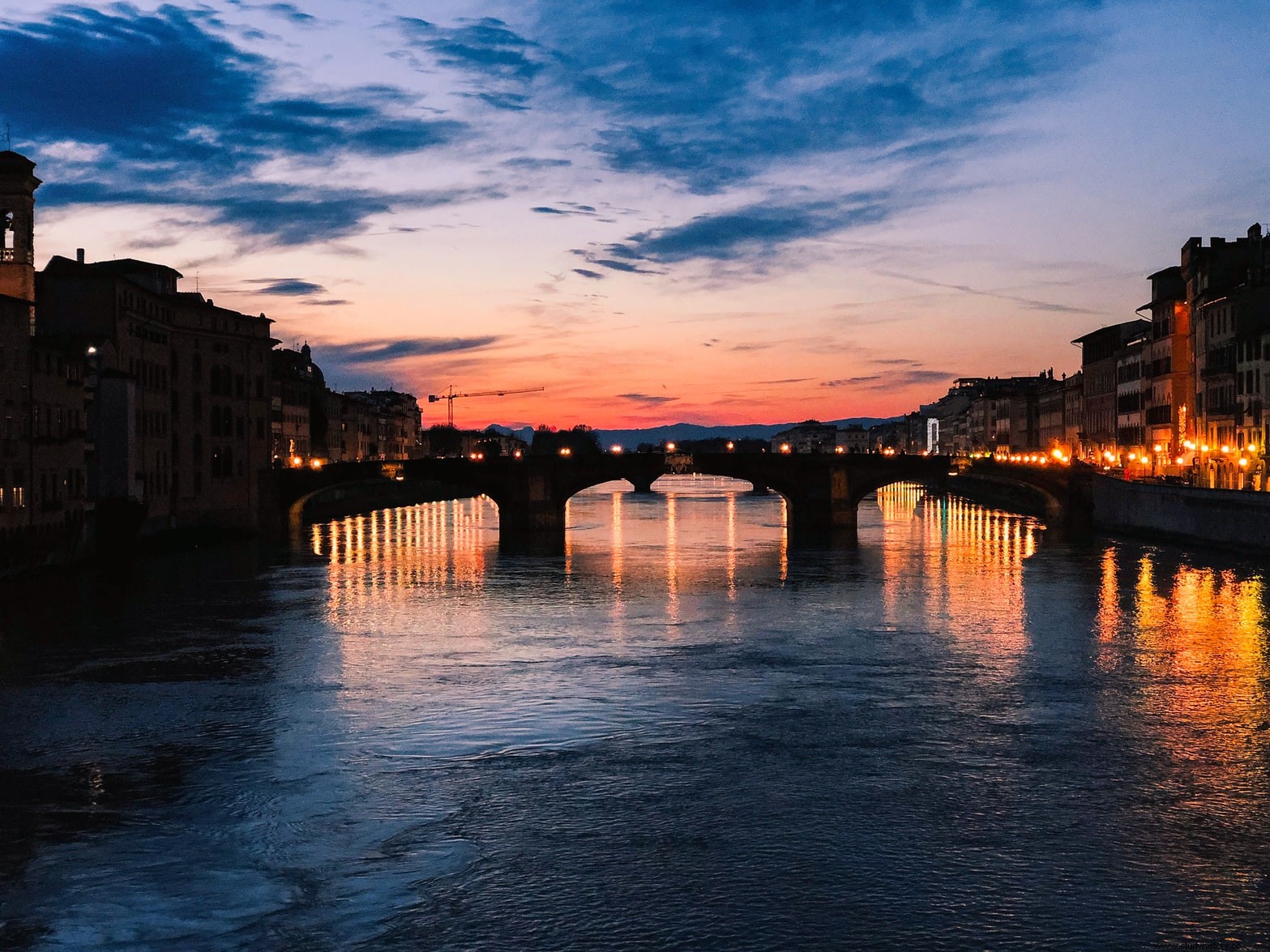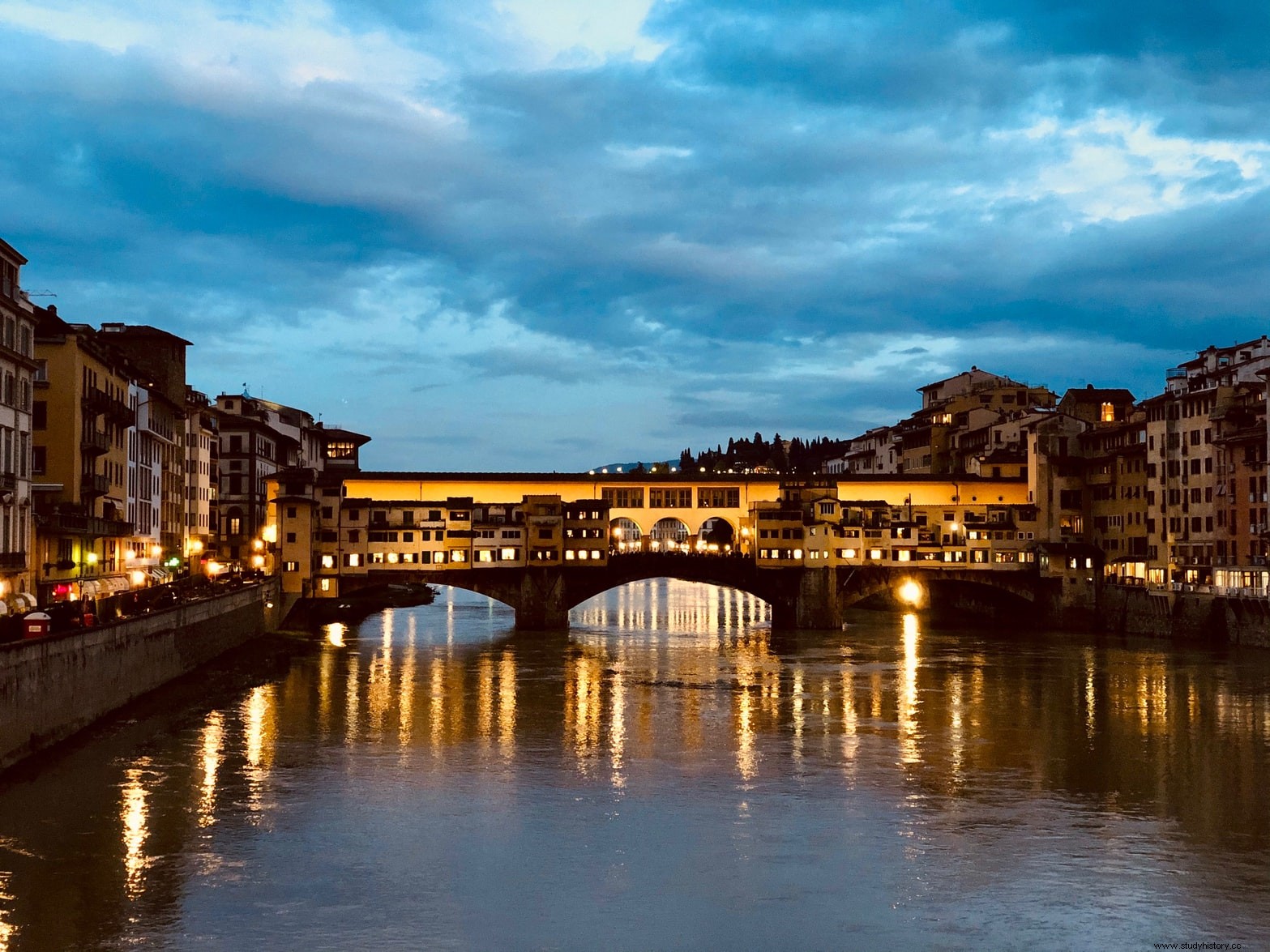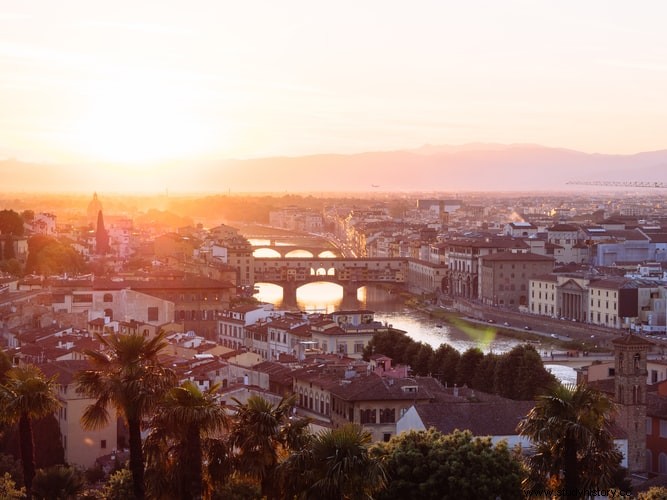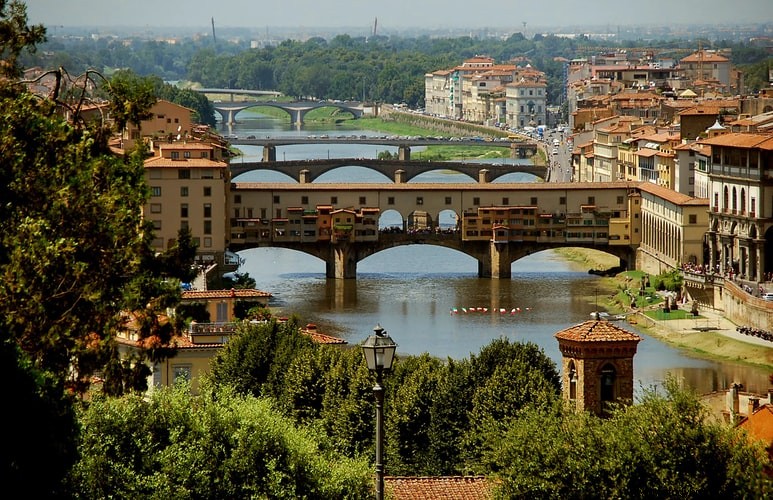You must have heard of London Bridge, Brooklyn Bridge, Golden Gate Bridge, etc. There is another famous bridge in Florence, Italy Ponte Vecchio. Also called the Golden Bridge, the closed arch, the arch bridge of the river Arno, is a famous tourist destination. After the destruction of the former bridges due to flooding, a stronger, flood-resistant bridge was reconstructed in 1345. But if you want to buy gold jewelry, Ponte would be the right place. There are many medieval-style gold jewelery shops along the two sides of the bridge.

Florence and Ponte Vecchio
The Golden Bridge or Ponte Vecchio is a famous destination in Florence. The Italians call it Florence. Every year, about 13 million tourists are listed. Not only tourism, but also rubber, leather, furniture and a whole range of ready meals contribute to the economy of Florence. The "cradle of the Renaissance", ie the Arno River, is the most important lifeline of the Firen. It is a hub for rich heritage. Besides the Ponte Vecchio, the world-famous painting of Monalisa originated in Florence. Famous personalities like Raphael, Michelangelo, Dante, Galileo, etc have roots in Florence.
River Arno and Ponte Vecchio
The rivers Pesa, Sieve, Era and Elsa have combined to form the river Arno or Fume Arno. The river covers a distance of 240 km from the source in Tuscany and up to the Ligurian Sea. With Micheal Angelo's contribution to the flood relief system and the restoration of civilizations, the Arno River has gained an enormous reputation. The floods of 1966 wreaked havoc, not only in Florence but also in the Ponte Vecchio. The confluence between the river and the sea can be observed just outside Florence.
Previous days with Ponte Vecchio
After many years of transformation today, the bridge has gained enormous popularity. In the past, the bridge was a smelly place. This is because it was the wastes of butchers and tanneries that were dumped in the river. During that time it was allowed. Until the Grand Duke Ferdinand I in 1593, the old fishing, butcher and tannery culture overruled to make the place dirty. Instead, he welcomes the goldsmiths and goldsmiths to stop by the butchers and leather producers.
Tourist Attraction About the Ponte Vecchio
In addition to window shopping, medieval jewelry stores were located on two sides of the street. Visitors can also find entertainers. Some musicians may play music, some painters may draw portraits, eateries, souvenir shops, etc. may attract large tourists. The bridge is still busy all day. You can stop at any of the restaurants to try Italian cuisine.
History
In particular, the bridge Ponte Vecchio is 276 feet long. Also, it is 105 feet wide. Furthermore, there are three segment arches. Due to its goldsmiths and glittering jewelery shops, the Ponte Vecchio has been nicknamed the "Golden Bridge". Additional historical facts for you
- The bridge you can see today is not the original. In 996 AD was the first bridge constructed by the Romans. But as a result of floods first in 1117 and second in 1333, the bridge was destroyed. The threat of flooding continued over the years.
- In 1218, the wooden bridge that was made earlier was replaced with stones. Only the middle structures were left in the flood. However, the fifth new bridge in the 1350s was constructed with jewelry stores on both sides.
- The new bridge was built over the narrowest part of the river Arno that flows through the city. It was used as a corridor by the Medici family to connect Palazzo Pitti and Ponte Vecchio to their home.
- But historians are not sure exactly who created the bridge. Whether Taddeo Gaddi, Giovani de Campo, Dominican Friar was an innovator of the bridge.
The old sundial on the Ponte Vecchio
The Florentines used traditional sundials to predict time. Tourists may overlook it, but it is a lizard-like structure on a white pillar. In the absence of formal watches during that period, the sundials would help. The lizard is small to catch the eyes if it is not followed closely, and you know its existence

World War II and the Ponte Vecchio
The bridge Ponte Vecchio was the only bridge in Florence that survived World War II. The other bridges along with the houses in the Ponte Vecchio rumbled to pieces. But why was that? According to legend, Adolf Hitler's love for the bridge He visited the bridge in 1939 and was fascinated by the view of the Florence skyline. Together with other German colonels, they agreed to keep the bridge untouched.
In addition, the main course goes to Gerard Wolf. He was identified as an honorary citizen in 1955. In his honor, a marble slab was dedicated in the Ponte Vecchio in 2007.
Harmonics and Ponte Vecchio in 1966 Floods
During the flood in 1996, the river Arno became very turbulent. The participants in a museum were worried that the valuable pictures could be destroyed. To secure, they formed a human chain. It was later revealed that the humming bridge showed the greatest flexibility to withstand the vibrations of the flood. This proved the brilliance of the construction of the bridge and its resistance to accidents.
Multiple Business Terms and Ponte Vecchio
The words bankruptcy and architecture were born in the Ponte Vecchio. Furthermore, Benvenuto Cellini, the famous craftsman in the 4th century who designed the bridge structure and arches, gave rise to the word Architecture. In 1900, a bust of Cellini was created in the middle of the bridge by Raffaelo Romanelli to mark lovers.
Lockers of Love in Ponte Vecchio
Across Italy, the bridges are characterized by padlocks. Lovers used to put a little love lock where the Cellini bust and fountain are today. With a vision of having an eternal love life, the keys were released into the river Arno. Furthermore, Cellini was both a sculptor and a nature lover. The current situation is such that the government has removed most of the locks and banned the practice and imposed large fines.
River Arno and Ponte Vecchio
There was a risk of intruders approaching from the waterway, ie the river Arno. Although strategically reinforced, four towers were built to monitor waterway activity. Only the Mannelli Tower survived. Furthermore, the Manali Bridge was strategically built to the south of Florence. It also belonged to the Medici family. The beauty of the rivers has become a tourist attraction for sailing small boats. It was Renalis' brain child.
Recover funding from Ponte Vecchio
Now the bridge has become an important tourist destination. The former tenants of dirty butchers, fishermen and leathermakers have been replaced by goldsmiths and souvenir shops and restaurants that pay rent for their shops. This amount is reimbursed for expenses incurred during the construction of the bridge.
Shopping on the Ponte Vecchio
In recent times, Ponte Vecchio has become the sparkling shops. In addition to the handmade jewelry such as necklaces, earrings, rings, bracelets, etc., the Ponte Vecchio houses famous art galleries and souvenir shops. The souvenirs are great gifts for your friends back home. You can also buy them for personal use. Also, if you are at the bridge, a must-visit for the corner shop Fratelli Piccini is necessary. The store has been in operation since 1900, run by a single family. The guides can tell you how to reach or ask the locals for help.
The bridge is walkable, tourists walk around the bridge all day. The whole bridge is still crowded. The shops on the Ponte Vecchio start at 10 and is open until kl. 7 all week, except Sundays. However, if you want smaller crowds on bridge morning, 8.30 would be perfect. Similarly after 9 p.m.
Tips for visitors to the Ponte Vecchio
To avoid unparalleled problems, try the following tips:
- Take care of your belongings. In a crowded place there is a danger of pickpockets
- The area can be visited by walking. Therefore, it is suggested that you avoid bicycles. The area is easily walkable and you can easily visualize the silence instead.
- On photographs, if you want smaller audiences to follow the correct timing before opening and closing stores
- Being a favorite tourist destination, store suppliers can charge you heavily. You are suggested to negotiate a price until you reach a win-win situation.
Best time to visit Ponte Vecchio
Try between May and October the months that would be the best time to visit. The bridge, which is a public place, is open all the time. If shopping is not your intention, rather than enjoying the scenic beauty and photography is your preference early morning or late evening when you will encounter fewer people.
But if you have a motive for shopping, you can visit between 10 and 7 while the shops are open. Do not ignore the negotiation part. Or you may be lost.
Shopping ideas on the Ponte Vecchio
Shopping for gold ornaments mostly attracts visitors. Besides souvenirs from the place that became popular, it has been a long life for travelers to have a memory home. Some ideas:
- The ceramics from Montelupo belong to the Middle Ages
- GAB leather bags
- Leather gloves
- Bright golden jewelry, the specialty of the place.
- Shoes from Barmer
- Fragrant soaps, such as Florence, are known for their natural aroma
- Red beer, wine and chocolate

Now Ponte Vecchio
The nearest bus stations to Ponte Vecchio are Palazolo, Melegnano, Penta Vepucci, etc. Can be reached by bus route # 365A, # 23 ie ATAF buses. From Santa Maria Rly. Stn. They are well connected by bus routes that take you up to the Ponte Vecchio with 6 Euro up and 10 Euro down. Shuttle buses are available.
By train
You can use the R-line
By Light Trains
Try train lines T1 and T2
On foot
The city of Florence can be covered in 30 minutes by walking. You can also reach the Ponte Vecchio by walking.
By taxi
Ponte Vecchio can be reached by taxi as well. They charge you 20 euros from the airport. Either cash or your credit card can be used.
Some important information
The bridge is located in Florence, Italy. It is 11 km from Florence FLR airport. You can reach it by bus taxi or train. It is open all week. There are no entrance tickets for visitors. Only visit whenever you want.
Places near Ponte Vecchio Do not missThe nearby attractions you can not miss. They are nearby and desirable places for you
- The art gallery called the Uffizi, a collection mostly of the Medici family
- You must visit the Loggia Dei Lanzi built in the 14th century. It houses the statue of Persues after killing Medusa
- For more expensive purchases for jewelry or cloth. If you buy t-shirts or souvenirs, Mercato Nuovo would be perfect
- If you're looking for coffee shops, check out the roadside cafes owned by the Uberti family in Piazza del Signoria
- The attractive buildings of the type built in the 14th century can be seen at the Palazzo Vecchio
- You can also visit a church with a museum upstairs that was originally a grain market. The church is called Orsanmichel. Michelangelo's works can be found at the Bargello National Museum. It is a must-see destination.
- If greenery is desired, the Bardini Garden can be visited. Along with beautiful stairs, visitors can also see fountains apart from green areas.
- If you love museums, you can visit Palazzo Pitti, a large castle in Oltrarno. The castle houses many museums. There you can see the Palatine Gallery, a treasury for the Grand Dukes, the garment museum, costume and fashion. Further Modern Art Gallery.
Food options near Ponte Vecchio
Enjoy the taste of Italian cuisine while visiting the alleys of the Ponte Vecchio. Original Italian food contains diverse taste and flavor. For example, smoked eggs from Bottarga, pasta, lasagne, or maybe margarita from Naples, options are many. While visiting the Uffizi Gallery, it turned off from the Ponte Vecchio and there is a pizzeria on the street. If you are hungry, you can grab a small Mangia Pizza from there. What the Italians have to offer is quite affordable. Therefore, you will not have problems with the food part.

Synchronization with Anthropology
The bridge Ponte Vecchio is a well-known presentation of aesthetic and engineering knowledge of older age. The patient and the revival of strategies to build and rebuild the bridge is remarkable. It is quite surprising to realize how it survived World War II, even though the rest of the city was affected. The beauty of using arches and their strength to withstand natural disasters are brilliant structural strategies that have contributed to excellence. Even Adolf Hitler admired the beauty of the bridge. At one time it was a favorite destination when locks were used to make the bondage of love eternal. However, the government banned the process.
